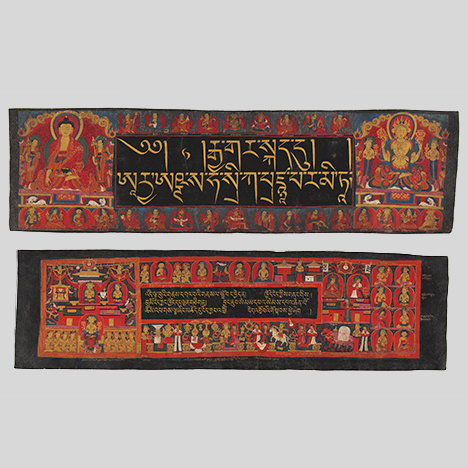
The writing’s on the wall, literally. We recently acquired two folios from a Tibetan illuminated manuscript featuring exquisite embossed calligraphy. On Tibetan Calligraphy Day, our curator of Himalayan art, Elena Pakhoutova, tells us about our museum’s history with this artwork and reveals why it’s so important to our collection.
Tell us a bit about this work and what we’re looking at here.
These two folios are the title page and frontispiece of the illuminated manuscript of The Perfection of Wisdom Sutra (Prajnaparamita) created in Western Tibet. They feature the patrons who commissioned the manuscript, and more importantly depict them as wishful participants in the story described in this sutra. The text is written in gold on dark blue paper, several sheets of which are glued together and then colored.
Why is this work significant?
The Perfection of Wisdom Sutra is considered the perfect representation of the Buddha’s teachings and is often commissioned to accumulate merit and good karma either on behalf of someone who passed away or on special occasions. The tradition of reading this sutra is also quite widespread in the Himalayas, and it is believed that the manuscript that contains the text of this sutra is itself the object of devotion. Such high-quality materials and beautiful images of this particular example indicate that the patrons who commissioned it had considerable resources.
What does the work bring to the Rubin collection?
We have very few paintings from Western Tibet in our collection, and these manuscript pages help us refine our understanding of the styles from that region so we can share their beauty with our visitors. The painting style of these illuminations has been compared to the 15th-century mural paintings in the famous Red Temple at Tsaparang in Western Tibet.
Have these folios been shown before?
Yes, they were part of a large exhibition at the Art Institute of Chicago and Arthur M. Sackler Gallery, Smithsonian Institute in Washington DC in 2003″“2004. Our museum has a history with these pages as well. They were on display in our 2011 cross-cultural exhibition Illuminated: The Art of Sacred Books, which presented Tibetan sacred books along with illuminated manuscripts from a variety of other traditions, including Japanese Buddhist scrolls, a Tunisian Qur’an, medieval Gospels, and illustrated Indian Hindu classics. At that time, they were loaned to us, so we’re excited that they can now be shown in future exhibitions as part of our collection.
Is there anything you find particularly exciting about these pages?
Speaking of calligraphy, I think it is one of the amazing examples of Tibetan art of the letters. If you look carefully at the golden letters of the title page you can see the embossing on the letters themselves. When the exhibition Illuminated was on view, a Korean artist who is reviving the tradition of gold sutra calligraphy and painting in Korea came to see the exhibition and was astonished by the mastery of this technique.

